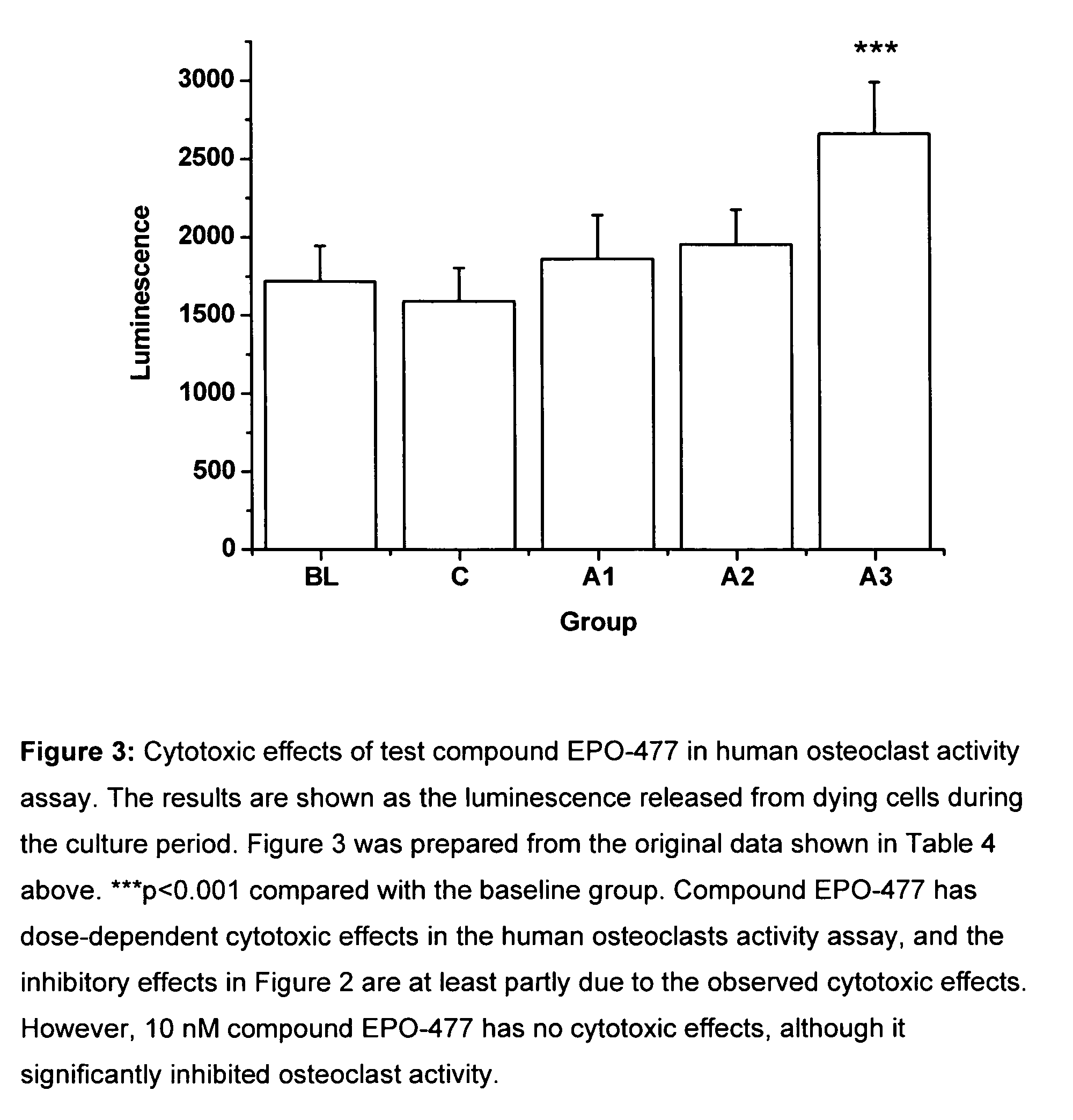Use of epothilones in the treatment of osteoporosis and related diseases
a technology of epothilones and osteoporosis, which is applied in the direction of immunological disorders, drug compositions, biocides, etc., and can solve problems such as significant side effects
- Summary
- Abstract
- Description
- Claims
- Application Information
AI Technical Summary
Benefits of technology
Problems solved by technology
Method used
Image
Examples
example 1
[0274]The objective of this study is to investigate the effects of selected test compounds selected on resorbing activity of human osteoclasts in vitro. Bone resorption is studied using a model where human osteoclast precursor cells derived from bone marrow are cultured for 7 days on bovine bone slices and allowed to differentiate into bone-resorbing osteoclasts. At day 7, the culture medium is changed, the test compounds are added, and the formed mature osteoclasts are allowed to resorb bone in an additional 3-day culture period. Tartrate-resistant acid phosphatase isoform 5b activity (TRACP 5b) is measured from the culture medium collected at day 7 as an index of the number of osteoclasts formed in each well during the differentiation period. After the totally 10 days culture period, C-terminal cross-linked telopeptides of type I collagen (CTX) are quantitated from the culture medium as an index of bone resorption. The results are expressed as the resorption index (CTX at day 10 / T...
example 2
Test Compounds
[0297]The test compounds used in this example are[0298](1S,3S,7S,10R,11S,12S,16R)-7,11-dihydroxy-3-(2-methyl-benzothiazol-5-yl)-10-(prop-2-en-1-yl)-8,8,12,16-tetramethyl-4,17-dioxabicyclo[14.1.0]heptadecane-5,9-dione (referred to as EPO-477) and paclitaxel.
[0299]From test compound EPO-477 a 10 mM stock solution was made by dissolving 10 mg compound in 1.839 ml of 96% EtOH.
[0300]The test compound paclitaxel was used as a 5 mg / ml (5.855 mM) stock solution. Paclitaxel is commercially available and is used for more than ten years for the treatment of cancer. Appropriate dilutions were made from the stock solutions to obtain the desired test concentrations; 2.5 nM, 5 nM, 7.5 nM, 10 nM, 15 nM, 20 nM and 50 nM for compound EPO-477 and 2.5 nM, 5 nM, 10 nM, 20 nM, 50 nM, 100 nM and 200 nM for compound paclitaxel in osteoclast activity assay
Description of the Study
[0301]The test compounds were added after osteoclast differentiation was completed at day 7, and the mature osteocla...
PUM
| Property | Measurement | Unit |
|---|---|---|
| concentrations | aaaaa | aaaaa |
| composition | aaaaa | aaaaa |
| structures | aaaaa | aaaaa |
Abstract
Description
Claims
Application Information
 Login to View More
Login to View More - R&D
- Intellectual Property
- Life Sciences
- Materials
- Tech Scout
- Unparalleled Data Quality
- Higher Quality Content
- 60% Fewer Hallucinations
Browse by: Latest US Patents, China's latest patents, Technical Efficacy Thesaurus, Application Domain, Technology Topic, Popular Technical Reports.
© 2025 PatSnap. All rights reserved.Legal|Privacy policy|Modern Slavery Act Transparency Statement|Sitemap|About US| Contact US: help@patsnap.com



